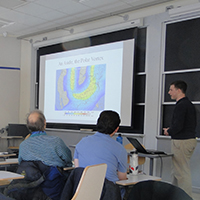
In climate change, science and policy are inextricably linked—more so than in most contemporary social phenomena. The complexity of understanding earth’s systems generates uncertainty, which feeds into an imperfect policy process that often warps ideal economic instruments beyond recognition. Without clear recognition of this linkage, the resulting mixture is frequently less than appetizing. This January, we continued an MIT Joint Program on the Science and Policy of Global Change tradition of presenting to the MIT community the basics (and some of the nuance) of this complex issue over a two-session Independent Activities Period (IAP) course.
While the minutiae of a 3-dimensional atmosphere and ocean model may be daunting (and require clusters of networked high-performance computers to complete a run), it turns out we can understand a lot about climate change from simplified models that build on basic physics accessible to any first-year undergraduate. Fundamental principles, such as energy balance, yield straightforward arguments about why the Earth should warm as we add greenhouse gases to its atmosphere. Those same principles can also be used to frame simple predictions about how future warming might proceed—information that policymakers and analysts can use to help plan for the future.
Considering climate change as an “externality” (a cost imposed on society by individuals and companies without compensation), economists have developed theories of how to reduce environmental impacts by appealing to pocketbooks. Putting a price on pollution (e.g., carbon tax) or selling and trading “rights” to pollute (e.g., cap-and-trade) are two common policy levers to encourage polluters to cut back while lessening the overall economic impact. When we couple our global climate models with global economic models (collectively, the Integrated Global System Modeling framework – IGSM), we can better understand the complex interactions between human activities and earth system changes.
We are invariably asked: Do we prefer to tax or to trade? Strictly economically speaking, if we have perfect information on the damages from climate change and the costs required to mitigate, the two should be equivalent. However, accounting for uncertainties on both ends of the human-earth interaction, we find that our answer from a strictly modeling perspective depends on which we can estimate better: the social cost of carbon (the total cost to society of the externality) or the “tipping point” thresholds of irreversible climate change? This is an area of ongoing research.
Policy-makers tend to respond to what they can see, an important part of the policy-science nexus of climate change. Typhoon Haiyan, which devastated the Philippines last November, stood as a stark reminder of the human suffering from extreme weather events—as did Hurricanes Sandy and Katrina on the domestic front. Hitting land just as the annual UN climate talks opened in Poland, Haiyan (or Yolanda, in the Philippines) became an impetus for international efforts there to create the beginnings of a “Warsaw Mechanism”, an international compensation scheme for loss and damage resulting from climate change. Predicting how the frequency and severity of such storms will change in a warming world is a crucial research focus, particularly as society builds more densely along coasts and in floodplains and exposes itself to more potential economic and personal loss.
Ultimately—unlike the Earth’s orbit—no policy issue exists in a vacuum. As we described examples of current efforts in the US, China and the EU to reduce greenhouse gas emissions, it is rare that the best of both science and economics are captured by policies in practice. The prevailing politics have a large impact on where the needle lands—tax, trade or other—and indicate an even bigger challenge that lay before us, not as scientists but as citizens.
Daniel Rothenberg and Daniel Gilford are graduate students in MIT’s Department of Earth and Planetary Sciences. Michael Davidson and Arthur Yip are graduate students in MIT’s Engineering Systems Division.


